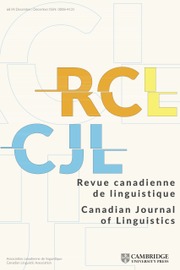No CrossRef data available.
Article contents
Parsing in the Minimalist Program: On SOV Languages andRelativization
Published online by Cambridge University Press: 27 June 2016
Abstract
I examine computational issues in the processing of SOV languages in theprobe-goal theory of the Minimalist Program. A theory that minimizes search,such as the probe-goal theory, provides a strong linguistic basis for theinvestigation of efficient parsing architecture. For parsing, two main designchallenges are presented: (i) how to limit search while incrementally recoveringstructure from input without the benefit of a pre-determined lexical array, and(ii) how to come up with a system that not only correctly resolves parsingambiguities, but does so with mechanisms that are architecturally justified. Itake as the starting point an existing probe-goal parser with features thatallow it to compute syntactic representation without recourse to derivationhistory search. I extend this parser to handle pre-nominal relative clauses ofthe sort found in SOV languages. I provide a unified computational account offacts on possessor (and non-possessor) relativization and processing preferencesin Turkish, Japanese, and Korean.
Résumé
Je m’adresse ici à des questions d’ordre informatique dansle traitement des langues SOV à l’intérieur de lathéorie sonde-cible (probe-goal) du programmeminimaliste. Une théorie qui minimise l’effort de la fouille,telle que la théorie sonde-cible, donne une forte base linguistique pourl’investigation d’une architecture efficace des analyseurssyntagmatiques des langues naturelles.
Pour cette dernière, deux défis d’ordre conceptuel seprésentent : (i) comment limiter la fouille par incréments tout enrécupérant la structure des données d’entréesans faire appel à un ensemble lexical prédéterminéet (ii) comment développer un système qui peut non seulementrésoudre des ambiguïtés d’analyse, mais qui le faitsur la base de mécanismes qui sont justifiés parl’architecture. Comme point de départ, je prends un analyseursonde-cible préexistant avec des traits qui permettent un calcul de lareprésentation syntaxique sans recours aux étapesdérivationelles antérieures de la fouille. J’étendsl’application de cet analyseur aux relatives prénominales qui setrouvent dans les langues SOV. J’offre une analyse unifiée dutraitement informatique de la relativisation des possesseurs (etnon-possesseurs) et des préférences de traitement en turc, enjaponais et en coréen.
Information
- Type
- Articles
- Information
- Canadian Journal of Linguistics/Revue canadienne de linguistique , Volume 53 , Issue 2-3 , November 2008 , pp. 237 - 252
- Copyright
- Copyright © Canadian Linguistic Association/Association canadienne de linguistique 2008

